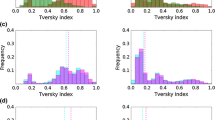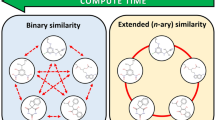Summary
Exchange of chemical information without disclosure of the respective structures would greatly increase the data sets available for model building. Within the framework of the ChemMask project we explored the principal applicability of SIBAR-descriptors to mask chemical structures. SIBAR is based on calculation of similarity values for each compound of the training set to a set of reference compounds. Although the SIBAR-approach per se does not allow to unambiguously trace back the chemical structure of a compound, similarity searching in a 1.5 million compound database spiked with compounds structurally analogous to the query structure lead to the retrieval of compounds structurally and pharmacologically highly analogous to the “hidden” query structure in all three examples investigated. Comparison to results obtained with the original descriptors used to calculate the SIBAR-values showed, that SIBAR indeed adds some fuzziness to the data matrix.
Similar content being viewed by others
Explore related subjects
Discover the latest articles and news from researchers in related subjects, suggested using machine learning.References
Bologa, C.G., Olah, M. and Oprea, T.I., Abstracts of Papers, 229th ACS National Meeting, San Diego, CA, March 2005, pp. 13–17
Gottesman M.M., Fojo T., Bates S.E., (2002) Nature Rev. Cancer 2: 48
Aronov A.M., (2005) Drug Discov. Today 10: 149
Ekins S., (2004) Drug Discov. Today 9: 276
Ecker, G., Chem. Today, 23 (2005) 39
Allu, T.K., Bologa, C. and Oprea, T.I., Safe Exchange of Chemical Information – The ChemMask Project, http://pimento.health.unm.edu
Austin C.P., Brady L.S., Insel T.R., Collins F.S., (2004) Science 306: 1138
Pastor, M., Cruciani, G. and Watson, K.A., J. Med. Chem., 40 (1997) 4089; Almond 3.3.0, Molecular Discovery, www.moldiscovery.com
Crivori, P., Cruciani, G., Carrupt, P.-A. and Testa, B., J.␣Med. Chem., 43 (2000) 2204; VolSurf 4.1.3, Molecular Discovery, www.moldiscovery.com
Gasteiger J., Teckentrup A., Terfloth L., Spycher S., (2003) J. Phys. Org. Chem. 16: 232
ADRIANA.Code, Molecular Networks, Germany; www.mol-net.de
Labute P., (2000) J. Mol. Graph. Mod. 18: 464
ChemNavigator, www.chemnavigator.com
Klein C., Kaiser D., Kopp S., Chiba P., Ecker G.F., (2002) J. Comp.-Aided Mol. Design 16: 785
Molecular Operating Environment, Chemical Computing Group Inc.; www.chemcomp.com
SPECS Inc., www.specs.net
Enamine, www.enamine.net
Maybridge; www.maybridge.com
ChemDiv, www.chemdiv.com
UNITY database, Tripos Inc., www.tripos.com
Acknowledgements
We gratefully acknowledge financial support from the City of Vienna, Hochschuljubilaeumsstiftung grant H-1236/2003. We are also grateful to Johnny Gasteiger for providing us with an ADRIANA license and to the Vienna University Computer Center for the UNITY software package.
Author information
Authors and Affiliations
Corresponding author
Rights and permissions
About this article
Cite this article
Kaiser, D., Zdrazil, B. & Ecker, G.F. Similarity-based descriptors (SIBAR) – A tool for safe exchange of chemical information?. J Comput Aided Mol Des 19, 687–692 (2005). https://doi.org/10.1007/s10822-005-9000-8
Received:
Accepted:
Published:
Issue Date:
DOI: https://doi.org/10.1007/s10822-005-9000-8
Keywords
Profiles
- Gerhard F. Ecker View author profile




